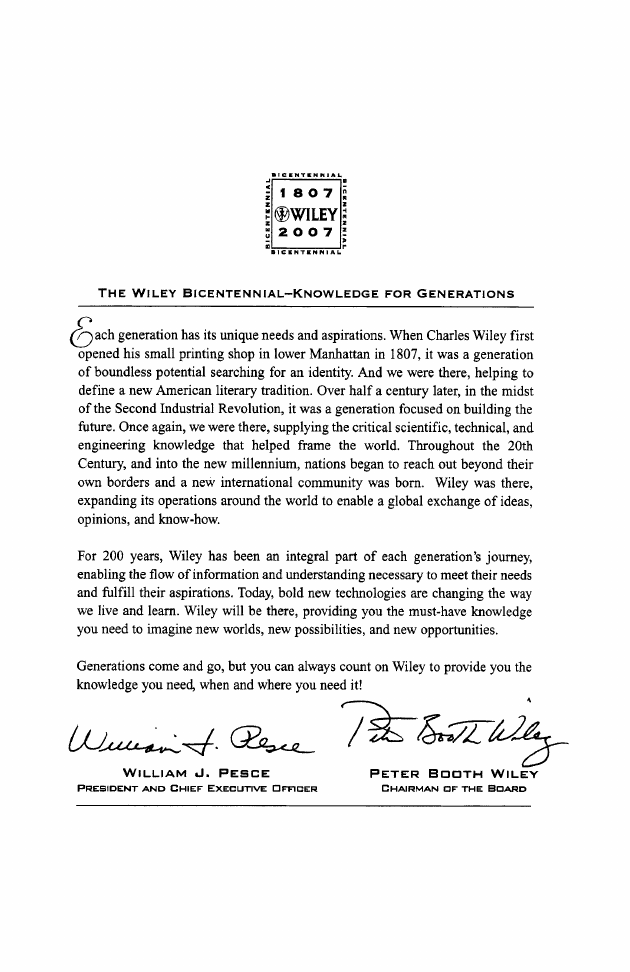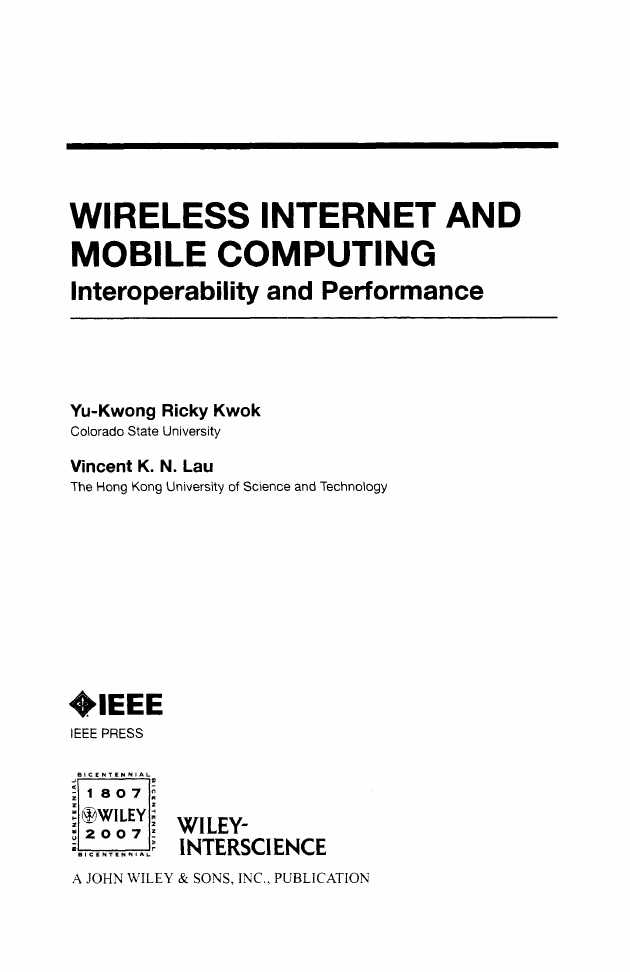WIRELESS INTERNET AND MOBILE COMPUTING
CONTENTS
Preface
Acknowledgments
Acronyms
PART I ESSENTIALS OF WIRELESS COMMUNICATIONS
1 The Mobile Radio Propagation Channel
1.1 Introduction
1.2 Large Scale Path-loss
1.3 Shadowing Effects
1.4 Small Scale Multipath Fading Effects
1.5 Practical Considerations
1.6 Summary
Problems
2 Modulation Techniques
2.1 Introduction
2.2 Signal Space and Geometric Representation of Signals
2.3 Modulation Design and Signal Constellations
2.4 Demodulation Design and Optimal Detection in AWGN Channels
2.5 Performance and Tradeoffs
2.6 Practical Illustrations: Digital Modulation
2.7 Summary
Problems
3 Multiuser Communications
3.1 Introduction
3.2 Information Theoretic Overview
3.3 Orthogonal Resource Partitioning
3.4 Non-Orthogonal Resource Partitioning
3.5 Spectral Efficiency and Performance Issues
3.6 Practical Illustrations: GSM, CDMA and Wireless LAN
3.7 Summary
Problems
4 Diversity Techniques
4.1 Introduction
4.2 Effects of Flat Fading on BER Performance
4.3 Effects of Frequency Selective Fading on BER Performance
4.4 Diversity: A Key Technique to Combat Flat Fading Channels
4.5 Equalization
4.6 Practical Illustration: RAKE Receiver
4.7 Summary
Problems
PART II CELLULAR WIRELESS TECHNOLOGIES
5 Overview and Evolution of Cellular Technologies
5.1 Introduction
5.2 Evolution of Cellular Systems
5.3 Technical Challenges to Realize 3G Services
5.4 Summary
Problems
6 CDMA (IS-95)
6.1 Introduction
6.2 System Architecture of IS95
6.3 Physical Layer and Physical Channels
6.4 Call Processing
6.5 Power Control
6.6 Soft Handover
6.7 Summary
Problems
7 GSM
7.1 Introduction
7.2 GSM System Architecture
7.3 GPRS System Architecture
7.4 Radio Interface
7.5 Core Network Interface and Services
7.6 Summary
Problems
8 Wideband CDMA and Beyond
8.1 Introduction
8.2 UMTS Architecture
8.3 Packet Switched Connections in UMTS (Rel 99)
8.4 Packet Scheduling in HSDPA (Rel 5)
8.5 Summary
Problems
PART III SHORT-RANGE WIRELESS TECHNOLOGIES
9 IEEE 802.11X WLAN Standards
9.1 Introduction
9.2 Design Goals
9.3 IEEE 802 Architecture
9.4 IEEE 802.11 MAC Layer
9.5 IEEE 802.11 Physical Layers
9.6 IEEE 802.1 le for QoS Provisioning
9.7 Advanced Developments
9.8 Practical Illustration: Home Network
9.9 Summary
Problems
10 Bluetooth WPAN
10.1 Introduction
10.2 Design Goals
10.3 Bluetooth Protocol Stack
10.4 Bluetooth Physical and MAC Layers
10.5 Piconets and Scatternets
10.6 Performance Issues
10.7 Practical Illustration: Sensor Network
10.8 Summary
Problems
11 Coexistence issues
11.1 Introduction
11.2 The ISM Band Spectrum
11.3 Packet Collision
11.4 Possible Solutions
11.5 IEEE 802.15 TG2
11.6 Interference Source Oriented Adaptive Frequency Hopping
11.7 Interference Source Oriented Master Delay MAC Scheduling
11.8 Performance Issues
11.9 Practical Illustration: Bluetooth and Wi-Fi Colocate Transmissions
11.10 Summary
Problems
12 Competing Technologies
12.1 Introduction
12.2 IrDA
12.3 HomeRF
12.4 HIPERLAN
12.5 Practical Illustrations—Implementation of HIPERLAN
12.6 Summary
Problems
PART IV PROTOCOL ADAPTATIONS FOR WIRELESS NETWORKING
13 Mobile IP
13.1 Introduction
13.2 Advertisement Mechanisms
13.3 Registration
13.4 Tunneling Approaches
13.5 Route Optimizations
13.6 Practical Illustrations—Hierarchical Mobility Management
13.7 Summary
Problems
14 IPv6
14.1 Introduction
14.2 Design Goals
14.3 Mobility Support
14.4 Home Agents Discovery
14.5 Practical Illustrations—IPv6 Based VTHD Network
14.6 Summary
Problems
15 Wireless Application Protocol (WAP)
15.1 Introduction
15.2 WAP Service Model
15.3 WAP System Architecture
15.4 WAP Protocol Stack
15.5 WAP Profiles and Caching
15.6 Practical Illustrations—Location-Aware Advertising System
15.7 Summary
Problems
16 TCP over Wireless
16.1 Introduction
16.2 TCP Congestion and Error Control
16.3 Deficiencies and Overview of Solutions
16.4 Link Layer Approaches
16.5 Split Connection Approaches
16.6 End-to-End Approaches
16.7 Practical Illustrations—Wireless WAN
16.8 Summary
Problems
PART V WIRELESS RESOURCES MANAGEMENT
17 Wireless Packet Scheduling
17.1 Introduction
17.2 The Scheduling Problem
17.3 System Model
17.4 Fairness Notions
17.5 Fair Queueing Approaches
17.6 Practical Illustrations—HSDPA
17.7 Summary
Problems
18 Power Management
18.1 Introduction
18.2 Characterization of Power Consumption
18.3 Power Conservation Schemes
18.4 Performance Issues
18.5 Practical Illustrations—The PC
MAC Scheme
18.6 Summary
Problems
19 Ad Hoc Routing
19.1 Introduction
19.2 Application Scenarios
19.3 System Model
19.4 Performance Metrics
19.5 Routing Protocols
19.6 Practical Illustrations—WLAN Based Ad Hoc Routing
19.7 Summary
Problems
20 Wireless Data Caching
20.1 Introduction
20.2 Application Scenarios
20.3 System Architecture
20.4 Performance Metrics
20.5 Data Caching Approaches
20.6 Practical Illustrations—Proactive Key Caching
20.7 Summary
Problems
21 Security Issues
21.1 Introduction
21.2 Security Considerations
21.3 Cellular Wireless Security
21.4 Short-Range Wireless Security
21.5 Practical Illustrations—Wireless LAN Security Auditing
21.6 Summary
Problems
PART VI MOBILE COMPUTING APPLICATIONS
22 VolP on Wireless
22.1 Introduction
22.2 iGSM VoIP Approach
22.3 iGSM System Architecture
22.4 iGSM Call Processing
22.5 Practical Illustrations—Problems and Solutions for VoIP over IEEE 802.11
22.6 Summary
Problems
23 Wireless Video
23.1 Introduction
23.2 Real-Time Service Goals
23.3 System Constraints
23.4 Error Concealment Techniques
23.5 Joint Source Channel Coding Techniques
23.6 Practical Illustrations—Rate Adaptation for MPEG-4 Video
23.7 Summary
Problems
24 Wireless File Systems
24.1 Introduction
24.2 File System Service Model
24.3 General Principles for the Design of a Distributed File System
24.4 Replication Services and Mechanisms
24.5 Disconnected Operations and Caching
24.6 Weakly Connected Operations
24.7 Practical Illustrations—Mobile Distributed Database
24.8 Summary
Problems
25 Location Dependent Services
25.1 Introduction
25.2 Mobile Location Service Model
25.3 Spatial Analysis Techniques
25.4 Mobile Positioning Techniques
25.5 Practical Illustrations—The Cricket Location Support System
25.6 Summary
Problems
26 Trust Bootstrapping in Wireless Sensor Networks
26.1 Introduction
26.2 Key Predistribution
26.3 Key Predistribution with Deployment Knowledge
26.4 Key Establishment
26.5 Discussions and Future Work
26.6 Summary
Problems
27 Peer-to-Peer Computing over Wireless
27.1 Introduction
27.2 A Taxonomy of P2P Systems
27.3 Wired P2P Systems
27.4 Topology Control in Wireless Ad Hoc Networks
27.5 Media Objects Replication Techniques
27.6 Practical Illustrations—Localized Topology Control
27.7 Summary
Problems
28 Incentives in Peer-to-Peer Computing
28.1 Introduction
28.2 Incentive Issues in P2P Systems over the Internet
28.3 Incentive Issues in Wireless P2P Systems
28.4 Discussion and Future Work
28.5 Summary
Problems
Appendix A: Optimality of Minimum Distance Decoder
References
Topic Index
















 2023年江西萍乡中考道德与法治真题及答案.doc
2023年江西萍乡中考道德与法治真题及答案.doc 2012年重庆南川中考生物真题及答案.doc
2012年重庆南川中考生物真题及答案.doc 2013年江西师范大学地理学综合及文艺理论基础考研真题.doc
2013年江西师范大学地理学综合及文艺理论基础考研真题.doc 2020年四川甘孜小升初语文真题及答案I卷.doc
2020年四川甘孜小升初语文真题及答案I卷.doc 2020年注册岩土工程师专业基础考试真题及答案.doc
2020年注册岩土工程师专业基础考试真题及答案.doc 2023-2024学年福建省厦门市九年级上学期数学月考试题及答案.doc
2023-2024学年福建省厦门市九年级上学期数学月考试题及答案.doc 2021-2022学年辽宁省沈阳市大东区九年级上学期语文期末试题及答案.doc
2021-2022学年辽宁省沈阳市大东区九年级上学期语文期末试题及答案.doc 2022-2023学年北京东城区初三第一学期物理期末试卷及答案.doc
2022-2023学年北京东城区初三第一学期物理期末试卷及答案.doc 2018上半年江西教师资格初中地理学科知识与教学能力真题及答案.doc
2018上半年江西教师资格初中地理学科知识与教学能力真题及答案.doc 2012年河北国家公务员申论考试真题及答案-省级.doc
2012年河北国家公务员申论考试真题及答案-省级.doc 2020-2021学年江苏省扬州市江都区邵樊片九年级上学期数学第一次质量检测试题及答案.doc
2020-2021学年江苏省扬州市江都区邵樊片九年级上学期数学第一次质量检测试题及答案.doc 2022下半年黑龙江教师资格证中学综合素质真题及答案.doc
2022下半年黑龙江教师资格证中学综合素质真题及答案.doc